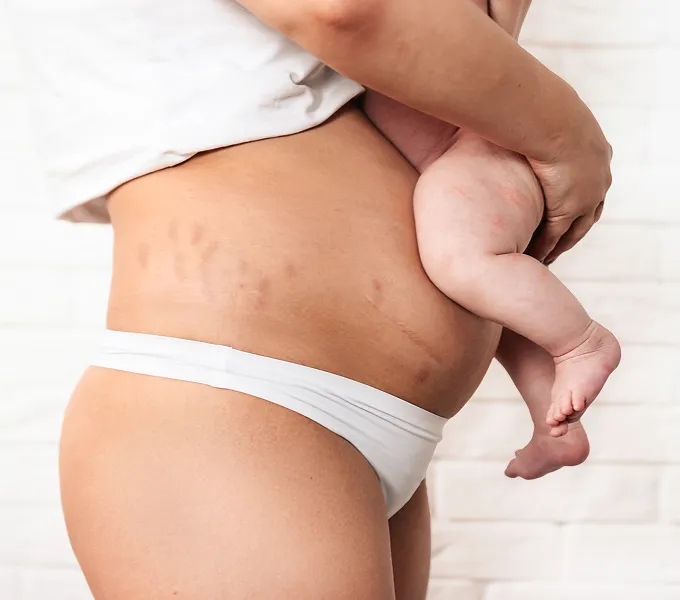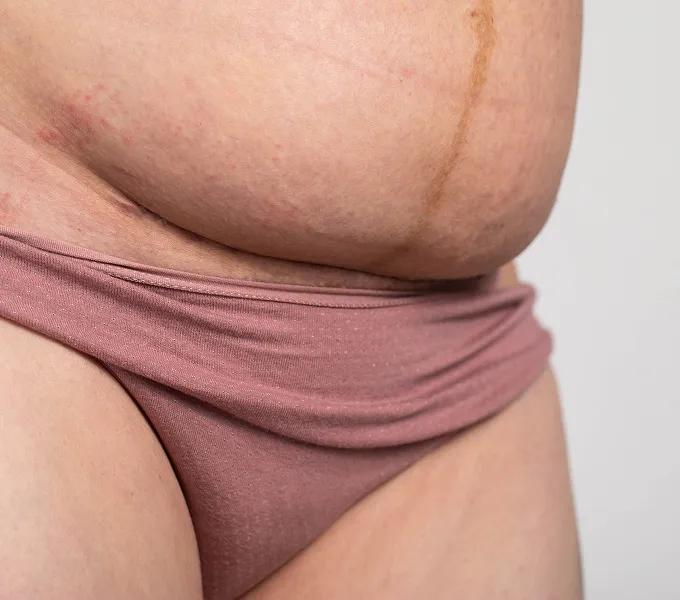
Why Does My Episiotomy Scar Hurt Years Later?
Vaginal childbirth is never a walk in the park, but thankfully the most painful parts of labor quickly become fuzzy memories (thank you hormones and neurochemicals!) so you can focus on your baby — who may now be a toddler or even older. Unfortunately, it's common for some other types of childbirth-related pain to linger on for a surprisingly long time, including scar pain from a perineal tear.
Even if you had an epidural during birth, you probably expected to have postpartum pain and swelling in your vulva and vaginal area as a normal part of healing. But what is going on when the pain sticks around for months or years, and causes symptoms like stabbing or stinging when you sit, exercise, or have sex?
Whether the scar was a result of a natural tear or an episiotomy (a surgical cut between the vaginal and anal openings that allows for a quicker birth and/or can prevent major tearing injuries), there is plenty that you can do to help manage this frustrating pain. Read on to learn more.
What makes an episiotomy scar hurt — after childbirth and years later?
Research shows that up to 92% of people will have perineal pain in the immediate days after a vaginal delivery. Following an expected course of healing, this pain should continue to improve, resolving in most by the 8th week of the postpartum period.
But pain can stick around for 18 months or longer in up to 10% of those who had scarring after a vaginal delivery. What causes pain to resolve for some, but persist for others? A number of factors may be contributing:
The severity of your injuries - Whether you tore naturally, or had an episiotomy, the severity of your injury is usually classified by degrees 1-4. Research has shown that the more involved/severe your injury, the more likely you are to have long-term perineal pain in the postpartum. Here is how perineal injury is typically classified:
- First degree: a superficial tear of that may include the skin of the vulva or mucosal tissue of the vagina.
- Second degree: a deeper injury that includes a larger range of injured tissue that includes the skin or mucosal tissue, as well as any muscle of the perineum up to, but not including the muscle of the anal sphincter.
- Third degree: a more severe injury that includes all injured that is included in the 2nd degree tear, but also includes injury to the anal sphincter muscle.
- Fourth degree: considered the most significant perineal injury, during which the tissue is cut or torn through the perineal body, anus, and includes injury to the rectal mucosal tissues.
If you had an operative vaginal birth - For a number of reasons related to the health of you or your baby, forceps or a vacuum may be necessary for a safe birth. Both forceps or vacuum assistance are considered an operative vaginal birth and studies have shown that you are at an increased risk for having prolonged perineal pain. One likely reason for this is that operative vaginal births tend to result in a more severe perineal injury.
Re-injuring your wound before it can fully heal - Wounds are more likely to become chronic if they don't heal well, which is why it's important to take good care of your scar after birth. If there's any disruption in the healing process — like re-injury or even poor nutrition — inflammation could persist and lead to delayed or abnormal wound healing. This can cause excessive scar tissue and adhesions (scar tissue that joins layers of tissue together that normally shouldn't be joined), which may aggravate and lead to prolonged pain.
Central nervous system changes - Chronic scar pain could also be a sign of peripheral and central nervous system changes, which are similar to the changes that occur in other types of chronic pelvic pain. These changes generate, amplify, and maintain a sensation of pain.
Is there anything I can do after childbirth to minimize scar pain?
While there are some factors that are largely out of your control that increase your chances of developing chronic scar pain after birth (how significant your perineal injury was, and whether or not you had an operative delivery for example) there are steps to take in the postpartum period that can help protect the healing process, and minimize the chances of scar tissue from sticking around:
Ease pain and inflammation in the first few days after birth - Pain and inflammation is certainly expected in the first few days after birth, but helping to calm these symptoms early, you can help set the stage for healthy wound healing, and protect the area from re-injury. Try icing the area for about 10 minutes every few hours, use a “peri bottle” to rinse the area after using the restroom instead of wiping, and wear supportive undies like these which provide a gentle compression and support to the wounds.
Avoid constipation - Pooping in the postpartum is tricky, especially when battling lingering pregnancy related constipation, side effects from any pain medications, and pain related to perineal wounds. After birth, focus on eating high fiber foods, and getting plenty of water (especially if you are lactating), using proper toileting mechanics, and perineal splinting, to protect you scar from becoming reinjured, and ease postpartum poops.
Take postpartum sitz baths - A soothing sitz bath will help relieve pain and improve blood flow to promote muscle relaxation, hemorrhoid relief, and wound healing. Try filling your tub with just enough water to cover your bum and relax for 20 mins if you are able. You can use plain warm water, or you can add Epsom salt or an herbal sitz bath tablet like these.
Incorporate postpartum scar massage - Once tissues are fully healed, and your physician has cleared you to do so, postpartum perineal massage can help with scar mobilization and ease lingering scar pain, so you can feel good in your body again. There are many different techniques that you can use. The right techniques will depend on your scar’s specific needs, so check in with your pelvic floor physical therapist in order to learn about the scar massage treatment that's best for you.
My scar pain is sticking around. Now what?
More than just a pain to deal with, lingering postpartum perineal scar pain can lead to all sorts of issues including vulvar pain, pain with sex, and even pelvic floor muscle tightness or weakness, which can lead to a variety of other pelvic floor symptoms such as bowel or bladder issues.
If none of these tips work for you and you find yourself suffering from chronic discomfort—or if this kind of pain has never really stopped bothering you—it might be worth seeing your healthcare provider or scheduling a visit with a pelvic floor physical therapist to help you get to the bottom of your pain as soon as possible, and find the treatment options that are best for you.




